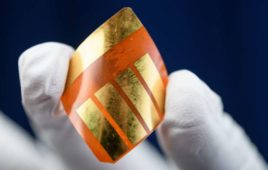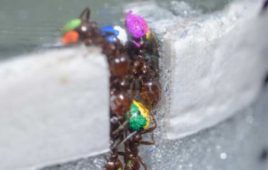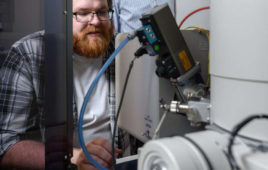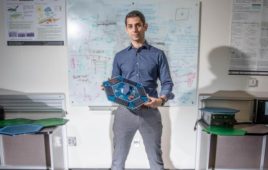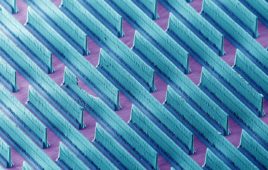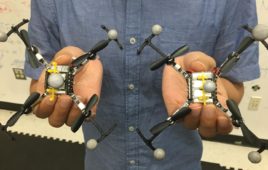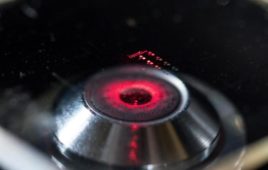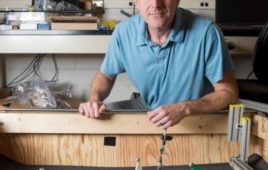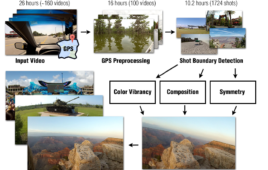Whether Harry Potter’s invisibility cloak, which perfectly steers light waves around objects to make them invisible, will ever become reality remains to be seen, but perfecting a more crucial cloak is impossible, a new study says. It would have perfectly steered stress waves in the ground, like those emanating from a blast, around objects like…
Morphing Origami Takes New Shape, Expanding Use Possibilities
Origami-based structures have been used to create deployable solar arrays for space, adaptable acoustic systems for symphony halls and even crash protection systems for flying drones. Now researchers at the Georgia Institute of Technology have created a new type of origami that can morph from one pattern into a different one, or even a hybrid…
Adhesive Formed From Bee Spit and Flower Oil Could Form Basis of New Glue
Honey bees spend hours each day collecting pollen and packing it into tidy bundles attached to their hind legs. But all of that hard work could instantly be undone during a sudden rainstorm were it not for two substances the insect uses to keep the pollen firmly stuck in place: bee spit and flower oil.…
Researchers Chart Path to Cheaper Flexible Solar Cells
There’s a lot to like about perovskite-based solar cells. They are simple and cheap to produce, offer flexibility that could unlock a wide new range of installation methods and places, and in recent years have reached energy efficiencies approaching those of traditional silicon-based cells. But figuring out how to produce perovskite-based energy devices that last…
Origami, 3D Printing Merge to Make Complex Structures in One Shot
By merging the ancient art of origami with 21st century technology, researchers have created a one-step approach to fabricating complex origami structures whose light weight, expandability, and strength could have applications in everything from biomedical devices to equipment used in space exploration. Until now, making such structures has involved multiple steps, more than one material,…
Control System Simulator Helps Operators Learn To Fight Hackers
A simulator that comes complete with a virtual explosion could help the operators of chemical processing plants – and other industrial facilities – learn to detect attacks by hackers bent on causing mayhem. The simulator will also help students and researchers understand better the security issues of industrial control systems. Facilities such as electric power…
More Workers Working Might Not Get More Done, Ants And Robots Show
For ants and robots operating in confined spaces like tunnels, having more workers does not necessarily mean getting more work done. Just as too many cooks in a kitchen get in each other’s way, having too many robots in tunnels creates clogs that can bring the work to a grinding halt. A study published August…
Sodium And Potassium-Based Batteries Could Be Key For Smart Grid Of The Future
From electric cars that travel hundreds of miles on a single charge to chainsaws as mighty as gas-powered versions, new products hit the market each year that take advantage of recent advances in battery technology. But that growth has led to concerns that the world’s supply of lithium, the metal at the heart of many of…
Project Will Provide Reaction Kinetics Data for Synthesis of Metallic Nanocrystals
Researchers have published the first part of what they expect to be a database showing the kinetics involved in producing colloidal metal nanocrystals – which are suitable for catalytic, biomedical, photonic and electronic applications – through an autocatalytic mechanism. In the solution-based process, precursor chemicals adsorb to nanocrystal seeds before being reduced to atoms that…
Piezoelectric Tiles Light the Way for Kennedy Space Center Visitors
Gecko Adhesion Technology Moves Closer to Industrial Uses
A gecko scampering up a wall or across a ceiling has long fascinated scientists and encouraged them to investigate how to harness lizard’s mysterious ability to defy gravity. While human-made devices inspired by gecko feet have emerged in recent years, enabling their wearers to slowly scale a glass wall, the possible applications of gecko-adhesion technology…
Perking Up and Crimping the ‘Bristles’ of Polyelectrolyte Brushes
If the bristles of a brush abruptly collapsed into wads of noodles, the brush would, of course, become useless. When it’s a micron-scale brush called a “polyelectrolyte brush,” that collapse can put a promising experimental drug or lubricant out of commission. But now a new study reveals, in fine detail, things that make these special…
Transfer Technique Produces Wearable Gallium Nitride Gas Sensors
A transfer technique based on thin sacrificial layers of boron nitride could allow high-performance gallium nitride gas sensors to be grown on sapphire substrates and then transferred to metallic or flexible polymer support materials. The technique could facilitate the production of low-cost wearable, mobile and disposable sensing devices for a wide range of environmental applications.…
‘Instant Replay’ For Computer Systems Shows Cyber Attack Details
Until now, assessing the extent and impact of network or computer system attacks has been largely a time-consuming manual process. A new software system being developed by cybersecurity researchers at the Georgia Institute of Technology will largely automate that process, allowing investigators to quickly and accurately pinpoint how intruders entered the network, what data they…
New Software Speeds Origami Structure Designs
Researchers at Georgia Institute of Technology have developed a new computer-aided approach that streamlines the design process for origami-based structures, making it easier for engineers and scientists to conceptualize new ideas graphically while simultaneously generating the underlying mathematical data needed to build the structure in the real world. Origami paper folding techniques in recent years…
Network Traffic Provides Early Indication Of Malware Infection
By analyzing network traffic going to suspicious domains, security administrators could detect malware infections weeks or even months before they’re able to capture a sample of the invading malware, a new study suggests. The findings point toward the need for new malware-independent detection strategies that will give network defenders the ability to identify network security…
Virtual Top Hats Allow Swarming Robots To Fly In Tight Formation
Georgia Institute of Technology researchers have created a team of free-flying robots that obeys the two rules of the air: don’t collide or undercut each other. They’ve also built autonomous blimps that recognize hand gestures and detect faces. Both projects will be presented at the 2017 IEEE International Conference on Robotics and Automation (ICRA) May 29 – June…
Chiral Metamaterial Produces Record Optical Shift Under Incremental Power Modulation
Georgia Institute of Technology researchers have demonstrated an optical metamaterial whose chiroptical properties in the nonlinear regime produce a significant spectral shift with power levels in the milliwatt range. The researchers recently demonstrated properties of their chiral metamaterial, in which they spectrally modified two absorptive resonances by incrementally exposing the material to power intensities beyond…
Once Overlooked, Uninitialized-Use ‘Bugs’ May Provide Portal for Hacker Attacks On Linux
Popular with programmers the world over for its stability, flexibilityand security, Linux now appears to be vulnerable to hackers. According to new Georgia Institute of Technology research, uninitialized variables - largely overlooked bugs mostly regarded as insignificant memory errors — are actually a critical attack vector that can be reliably exploited by hackers to launch…
Simulated Ransomware Attack Shows Vulnerability of Industrial Controls
Cybersecurity researchers at the Georgia Institute of Technology have developed a new form of ransomware that can take over control of a simulated water treatment plant. After gaining access, they were able to command programmable logic controllers (PLCs) to shut valves, increase the amount of chlorine added to water, and display false readings. The simulated…
Robot Helps Study How First Land Animals Moved 360 Million Years Ago
When early terrestrial animals began moving about on mud and sand 360 million years ago, the powerful tails they used as fish may have been more important than scientists previously realized. That’s one conclusion from a new study of African mudskipper fish and a robot modeled on the animal. Animals analogous to the mudskipper would…
Standardizing Communications for the Internet of Things
The fast-growing Internet of Things (IoT) consists of millions of sensing devices in buildings, vehicles and elsewhere that deliver reams of data online. Yet this far-flung phenomenon involves so many different kinds of data, sources and communication modes that its myriad information streams can be onerous to acquire and process. Researchers at the Georgia Tech…
Algorithm Allows Computer to Create Vacation Highlight Video
Researchers at the Georgia Institute of Technology unveiled a novel video-editing solution this week that automatically sorts and edits untouched footage into the most picturesque highlights for a vacation reel that could fill anyone with envy. The new approach is an algorithm—developed by students Daniel Castro and Vinay Bettadapura under the guidance of Professor Irfan…
Smart Hydrogel Coating Creates ‘Stick-Slip’ Control of Capillary Action
Coating the inside of glass microtubes with a polymer hydrogel material dramatically alters the way capillary forces draw water into the tiny structures, researchers have found. The discovery could provide a new way to control microfluidic systems, including popular lab-on-a-chip devices. Capillary action draws water and other liquids into confined spaces such as tubes, straws,…
New Method Improves Strength & Modulus in Carbon Fibers
Carbon fibers are stronger and lighter than steel, and composite materials based on carbon-fiber-reinforced polymers are being used in an expanding range of aerospace, automotive, and other applications – including major sections of the Boeing 787 aircraft. It’s widely believed, moreover, that carbon-fiber technology has the potential to produce composites at least 10 times stronger…



